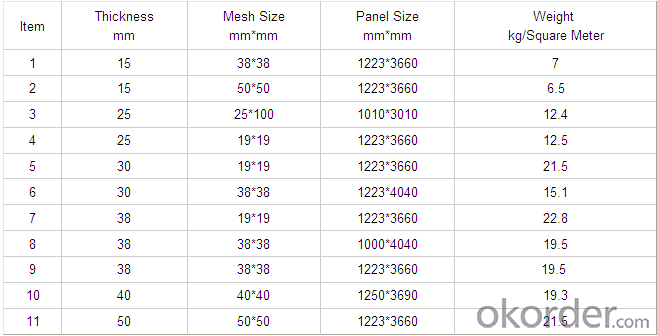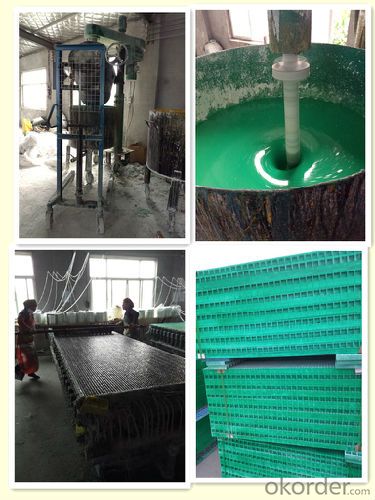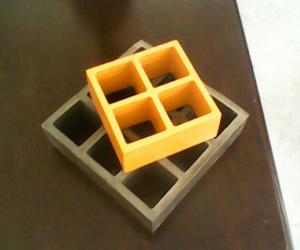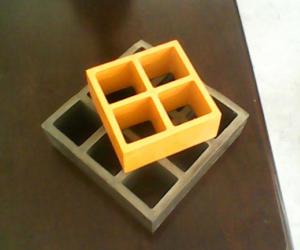FRP Molded Grating /GRP Grating / FRP Grating with all kinds of colors
- Loading Port:
- China main port
- Payment Terms:
- TT or LC
- Min Order Qty:
- 500 m²
- Supply Capability:
- 500000 m²/month
OKorder Service Pledge
OKorder Financial Service
You Might Also Like
Introduction
FRP Molded Grating is a structural panel which uses high-strength E-Glass roving as reinforcing material, thermosetting resin as matrix and then casted and formed in a special metal mold. It provides properties of light weight, high strength, corrosion resistance, fire resistance and anti-skid. FRP Molded Grating is widely used in oil industry, power engineering, water & waste water treatment, ocean survey as working floor, stair tread, trench cover, etc. and is an ideal loading frame for corrosion circumstances.
Feature
Corrosion Resistance
Fire Resistance
Light Weight & High Strength
Safety & Anti-slip
Electrical Insulating
Aging Resistance
Specification

Advantage
coated with prevent aging layer
excellent insulating performance
no maintenance
- easy installation
Application
- In high voltage electrical equipment for power line work, in order to prevent workers go wrong location, charged interval or near electrically charged equipment to dangerous distance.
Pool railings in sewage treatment industry
Corrosive chemical industry equipment around the fence
All kinds of building maintenance section
FAQ
1. How about the documents after shipment?
After shipment, we ll send all original documents to you by DHL, including Packing List.Commercial Invoice, B/L, and other certificates as required by clients.
2. How long is the delivery time?
Usually it takes 10-25days after receipt of the deposits or L/C, and it also depends on the quantity of your order.
3. Do You Arrange Shipment?
Yes, dear esteemed customers, for FOB or CIF price, we will arrange shipment for you. For EXW price, clients need to arrange shipment by themselves or their agents.
FACTORY

- Q:Are FRP pultrusion profiles resistant to chemicals used in food processing?
- The resistance of FRP pultrusion profiles to chemicals commonly used in food processing is generally high. FRP, a type of fiberglass reinforced plastic, is well-known for its exceptional chemical resistance, making it a suitable material for various industrial uses, including the food processing industry. These profiles are made by combining resins and fiberglass reinforcements, which give them inherent resistance to a wide array of chemicals. Acids, alkalis, solvents, and many other chemicals often found in food processing environments are typically resisted by FRP pultrusion profiles. This resistance ensures that the profiles will not corrode, degrade, or react with these chemicals, thus maintaining their structural integrity over time. Consequently, FRP pultrusion profiles are regarded as a dependable choice for equipment, structures, and components used in food processing facilities. However, it is important to note that the specific chemical resistance of FRP pultrusion profiles may vary depending on the resin system used in their production. Different resins offer different levels of resistance to specific chemicals. Therefore, it is crucial to carefully select the appropriate resin formulation that matches the specific chemical environment in the food processing industry. To ensure the compatibility of FRP pultrusion profiles with the chemicals commonly used in food processing, it is advisable to consult with the manufacturer or supplier. They can provide detailed information regarding the chemical resistance properties of their FRP profiles and assist in selecting the most suitable materials for the specific application. Additionally, proper maintenance and regular cleaning practices should be implemented to ensure the longevity and sustained chemical resistance of FRP pultrusion profiles in food processing environments.
- Q:What are the typical lifespan of FRP pultrusion profiles?
- The lifespan of FRP pultrusion profiles can vary depending on factors including material quality, environmental conditions, and specific application. On average, these profiles last 25 to 30 years. FRP pultrusion profiles are renowned for their durability and resistance to corrosion, rot, and UV radiation, which contributes to their extended lifespan. The use of top-notch resins and fibers during manufacturing ensures their ability to withstand harsh conditions and maintain structural integrity over time. It's worth mentioning that proper installation, regular maintenance, and adherence to usage guidelines can further increase the lifespan of FRP pultrusion profiles. Additionally, exposure to extreme temperatures, chemicals, and mechanical stress can impact their longevity. In summary, FRP pultrusion profiles provide a reliable and long-lasting solution for various applications in industries like construction, infrastructure, transportation, and marine.
- Q:Are FRP pultrusion profiles resistant to oil and grease?
- Yes, FRP pultrusion profiles are highly resistant to oil and grease due to the inherent properties of the fiberglass reinforcement used in their construction. The composite material offers excellent chemical resistance, making it suitable for applications where exposure to oil and grease is expected.
- Q:Can FRP pultrusion profiles be used in automotive applications?
- FRP pultrusion profiles can indeed be utilized in automotive applications, presenting a myriad of advantages that render them appropriate for such use. Firstly, these profiles possess the dual attributes of being lightweight and strong, which holds immense significance within the automotive industry. As weight reduction stands as a top priority for enhancing fuel efficiency and performance, the commendable strength-to-weight ratio of FRP profiles enables the creation of lighter vehicles that consume less fuel. Secondly, FRP pultrusion profiles exhibit exceptional corrosion resistance, a vital characteristic for automotive applications routinely encountering exposure to various chemicals, moisture, and harsh environments. This corrosion resistance ensures the long-term dependability and durability of the profiles, ultimately reducing maintenance expenses and prolonging the lifespan of automotive components. Moreover, FRP pultrusion profiles offer remarkable design flexibility, thereby facilitating the formation of intricate shapes and geometries that can be customized to meet specific automotive requirements. This flexibility allows for the seamless integration of FRP profiles into numerous automotive components, including body panels, structural supports, interior trims, and suspension parts. Additionally, FRP pultrusion profiles demonstrate high fatigue resistance, a crucial aspect for automotive applications that involve repetitive loading and vibrations. The fatigue resistance of FRP profiles guarantees their enduring performance and aids in averting failures and breakdowns. Lastly, FRP pultrusion profiles are non-conductive, an advantageous attribute in automotive applications necessitating electrical isolation. This property obviates the necessity for supplementary insulation and mitigates the risk of electrical failures and short circuits. All in all, the amalgamation of lightweightness, robustness, corrosion resistance, design flexibility, fatigue resistance, and electrical non-conductivity renders FRP pultrusion profiles suitable for diverse automotive applications, thereby contributing to enhanced performance, fuel efficiency, durability, and safety within the automotive industry.
- Q:Are FRP pultrusion profiles resistant to high winds or hurricanes?
- FRP pultrusion profiles offer exceptional resistance against high winds and hurricanes. Combining the robustness of fiberglass with the longevity of polymers, FRP is a lightweight yet remarkably sturdy material that can endure severe weather conditions. Extensive testing has proven that FRP pultrusion profiles exhibit outstanding wind resistance properties. They possess a remarkable stiffness-to-weight ratio, enabling them to withstand the powerful forces generated by high winds without deformation or breakage. Additionally, the inherent flexibility of FRP permits it to absorb and distribute wind forces, minimizing the risk of damage. In the face of hurricanes, FRP pultrusion profiles have demonstrated their capability to withstand the intense winds and airborne debris associated with such extreme weather events. They have been successfully employed in various applications, including building facades, bridges, and utility poles, in areas prone to hurricanes. Moreover, FRP pultrusion profiles possess corrosion resistance, providing an extra advantage in withstanding high winds and hurricanes. Unlike traditional materials like steel or wood, FRP profiles do not rust or decay when exposed to moisture, making them even more suitable for these demanding weather conditions. Overall, with their exceptional strength, durability, flexibility, and corrosion resistance, FRP pultrusion profiles are an excellent choice for applications requiring resistance against high winds or hurricanes.
- Q:Are FRP pultrusion profiles resistant to hydraulic oils?
- Yes, FRP pultrusion profiles are generally resistant to hydraulic oils. The combination of fiberglass reinforcement and resin matrix used in pultrusion manufacturing makes these profiles highly resistant to various chemicals, including hydraulic oils. However, it is recommended to consult the specific resin manufacturer or supplier for detailed information on the compatibility of their FRP pultrusion profiles with different types of hydraulic oils.
- Q:Can FRP pultrusion profiles be used in the construction of water slides?
- Water slides can indeed utilize FRP pultrusion profiles. FRP, which stands for Fiber Reinforced Polymer, is a composite material that offers numerous advantages in the construction of water slides. To begin with, FRP pultrusion profiles possess a remarkable combination of lightweight construction and remarkable strength, making them an ideal choice for creating the structural components of water slides. These profiles boast impressive strength-to-weight ratios, meaning they can withstand the dynamic loads and forces experienced in water slide applications without adding excessive weight to the overall structure. Moreover, FRP pultrusion profiles exhibit exceptional resistance to corrosion, which is of utmost importance in water slide construction. Given that water slides are constantly exposed to water, chemicals, and harsh weather conditions, traditional materials like steel tend to corrode and deteriorate over time. In contrast, FRP profiles are inherently corrosion-resistant, guaranteeing the longevity and durability of the water slide. Furthermore, FRP pultrusion profiles offer an abundance of design flexibility. They can be tailored to various shapes and sizes, enabling the creation of unique and thrilling water slide designs. These profiles are also easily moldable, allowing for the incorporation of various features such as slides, curves, and drops to enhance the overall water slide experience. Lastly, FRP pultrusion profiles possess exceptional thermal insulation properties. This proves advantageous for water slides as it helps maintain the temperature of the water, preventing excessive heat loss or gain. Such a feature enhances the comfort and enjoyment of users while simultaneously reducing energy consumption for heating or cooling the water. In summary, FRP pultrusion profiles are perfectly suited for water slide construction due to their lightweight nature, impressive strength, corrosion resistance, design flexibility, and thermal insulation properties.
- Q:What is the compression strength of FRP pultrusion profiles?
- The compression strength of FRP pultrusion profiles can vary depending on the specific design and manufacturing process. However, on average, FRP pultrusion profiles typically exhibit compression strengths ranging from 20,000 to 40,000 pounds per square inch (psi).
- Q:Are FRP pultrusion profiles resistant to hail or impact damage?
- Yes, FRP (Fiber Reinforced Polymer) pultrusion profiles are highly resistant to hail or impact damage. The combination of reinforcing fibers, such as carbon or glass, and a polymer resin matrix provides exceptional strength and durability to FRP pultrusions. These profiles have superior impact resistance compared to other materials like wood, steel, or aluminum. FRP pultrusion profiles are designed to withstand harsh environmental conditions, including hailstorms. The composite nature of FRP allows it to absorb and distribute impact energy, preventing the formation of cracks or fractures. This makes them an ideal choice for applications that require resistance to hail or impact damage, such as building facades, bridges, handrails, or utility poles. Furthermore, FRP pultrusion profiles have a high strength-to-weight ratio, meaning they can withstand heavy impacts without compromising their structural integrity. They are also non-corrosive, which makes them immune to rust or degradation caused by hail or impact. In summary, FRP pultrusion profiles are highly resistant to hail or impact damage due to their composite construction and excellent strength-to-weight ratio. They provide a reliable and long-lasting solution for applications that require durability and resistance to harsh environmental conditions.
- Q:What are the best manufacturers of glass fiber reinforced plastic pultruded profiles in China?
- We have made 2.5mm thick at the moment
1. Manufacturer Overview |
|
|---|---|
| Location | |
| Year Established | |
| Annual Output Value | |
| Main Markets | |
| Company Certifications | |
2. Manufacturer Certificates |
|
|---|---|
| a) Certification Name | |
| Range | |
| Reference | |
| Validity Period | |
3. Manufacturer Capability |
|
|---|---|
| a)Trade Capacity | |
| Nearest Port | |
| Export Percentage | |
| No.of Employees in Trade Department | |
| Language Spoken: | |
| b)Factory Information | |
| Factory Size: | |
| No. of Production Lines | |
| Contract Manufacturing | |
| Product Price Range | |
Send your message to us
FRP Molded Grating /GRP Grating / FRP Grating with all kinds of colors
- Loading Port:
- China main port
- Payment Terms:
- TT or LC
- Min Order Qty:
- 500 m²
- Supply Capability:
- 500000 m²/month
OKorder Service Pledge
OKorder Financial Service
Similar products
New products
Hot products
Related keywords






























